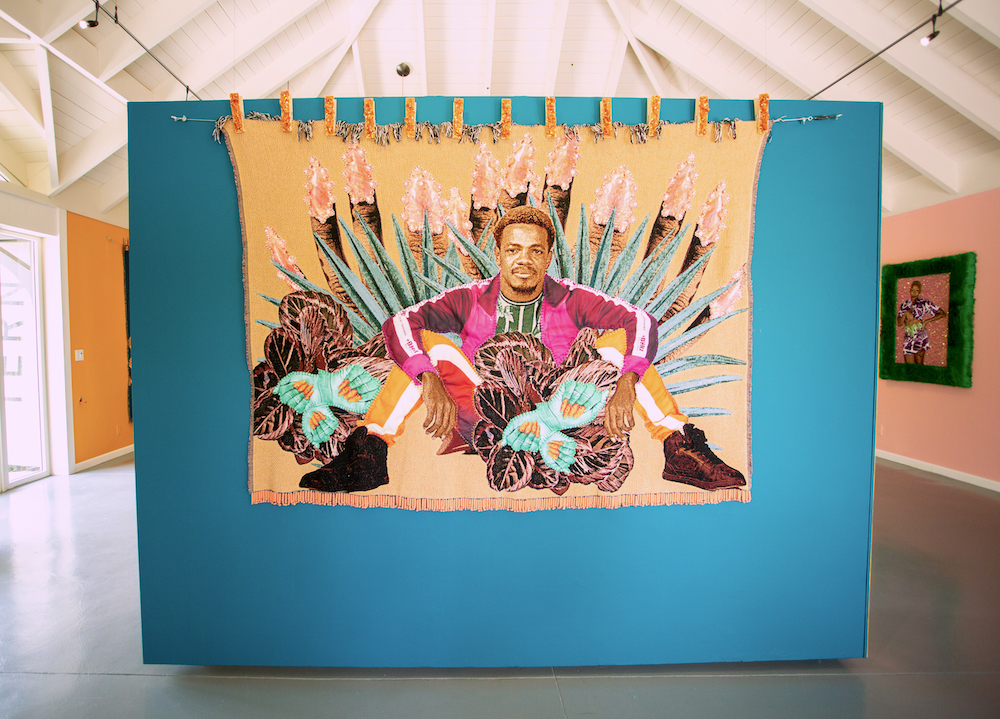April Bey’s “Colonial Swag” last spring was a homecoming for the artist. On view April 21–June 11, it took place at TERN Gallery in Nassau, The Bahamas, where the artist was raised. Now based in Los Angeles, Bey has a multidisciplinary practice that pushes materials like textiles to surprising limits. Her installations are often colorfully immersive—filled with texture, plant life, sparkle, and, as the title of her show suggests, swagger.
At the heart of the works on view at TERN Gallery—a mixture of large tapestries and smaller wall works, accented by faux fur walls and embellished clothespins—is the fictional story of Atlantica. The imaginary planet is home to an Afrofuturist world that allows for a Black experience outside of Earth’s colonial history and its traumas. The idea for this utopian, alien existence came from Bey’s father, a devoted Trekkie, who used it as a way to comfort his daughter when she felt judged or out of place growing up. He could tell her not to worry, that their family was from here, they were from Atlantica, a land free from racism.
Bey has beautifully expanded on the dream of Atlantica, exploring the possibilities of free expression in such a place, even imagining a native high-fashion luxury brand, named “Colonial Swag,” that is sustainably and ethically created. Whitewall spoke with Bey ahead of the opening, about breaking the rules in both material manipulation and image representation.
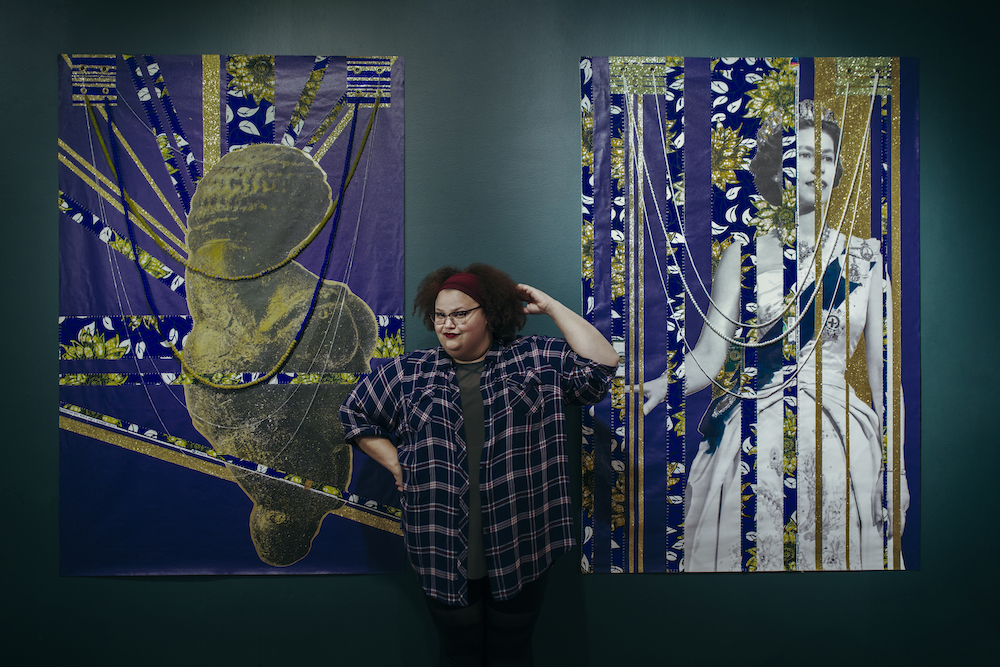
April Bey, courtesy of the artist and TERN Gallery.
WHITEWALL: What is Colonial Swag?
APRIL BEY: Colonial Swag is a fictitious high-fashion brand on a fictitious planet called Atlantica. The concept of the brand is that we mine ramifications of colonialism almost as if it were a raw material to make the fashion. This body of work is referencing anti-LGBTQ laws and cultural norms that were left over as a result of colonialism, and in particular British colonialism.
Colonial Swag comes from this thing that I’ve always done where, if there’s a problem, I like to understand the different components of the problem, to see if maybe certain parts of those components can be removed or replaced to make the problem go away. When I was in school and I was learning about colonialism and imperialism, I would have to break it down to understand what the components are. So in colonialism we have supremacy, and supremacy in the form of patriarchy and the form of white supremacy in the form of ableism, and how all of those things combined to create all of these systems that produce the ramifications lost cultures, lost languages, suppressed people, enslaved people, government exploitation, government corruption, and so on. If I can see all of those things as solid building blocks, and as actual ingredients for a recipe, it helps me understand and cope with the ramifications of it.
Colonial swag is a visual concept of that. The people in it reference those different colonial limitations. A lot of the people in the work that I shot for the show are queer. We had our first openly queer photo shoot here, and it was a really nice vibe. The narrative is being added to by people who follow the story.
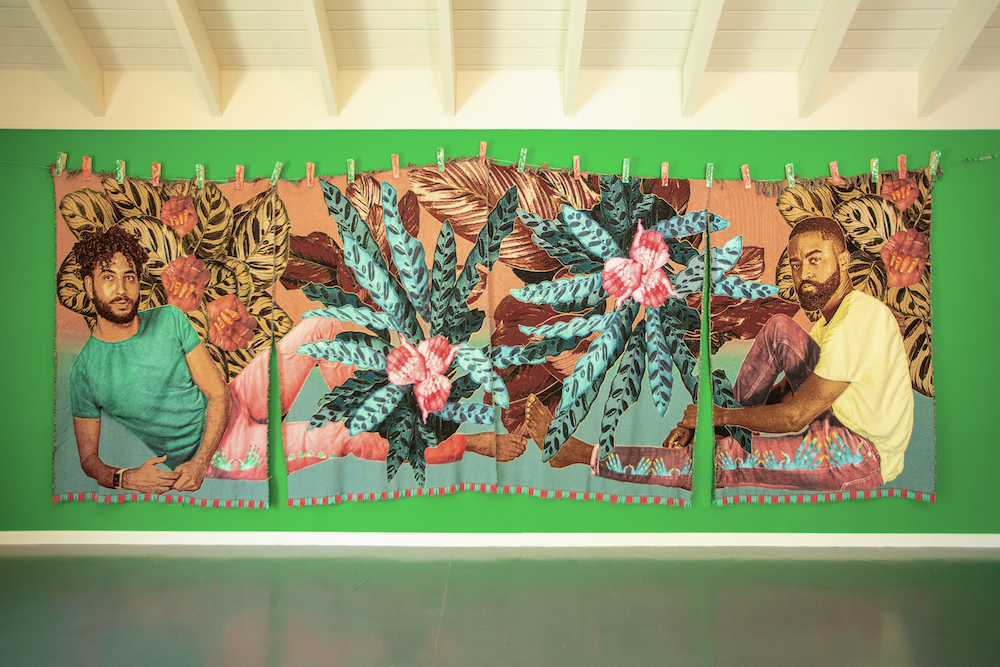
Installation view of April Bey’s “Colonial Swag” at TERN Gallery, photo by © Blair Meadows, courtesy of the artist and TERN Gallery.
WW: So what is the story of the planet Atlantica?
AB: Atlantica as a concept came from my dad. It was this story that he told me when I was young, and I started questioning why I had different physical attributes from other people. And by other people I mean white people. I didn’t understand why my hair didn’t fall the same way, why my nose looked different. I didn’t understand why we all looked different.
My dad was a huge sci-fi nerd, very into Star Trek, and it was his way of explaining things to me—we are aliens, and that’s why we look different, we were sent from another planet, and our mission is to observe and report on Earth. It was good enough for me at the time.
I gave the planet the name Atlantica, which is referencing all kinds of different things but mostly the Atlantic Ocean, which is what I grew up on.
WW: Can you tell us about the tapestries you’ve made from these images you collected? What materials were you drawn to for this show?
AB: West African beads, Chinese knockoff pearls, Chinese knockoff wax fabric—that’s very important in the work because I also like to compare flavors of colonialism. So British colonialism versus Chinese neocolonialism, which is our current colonial influence in both West Africa and the Caribbean. There’s going to be eco fur, satin, sequins, jacquard weavings, all combined, erroneously together.
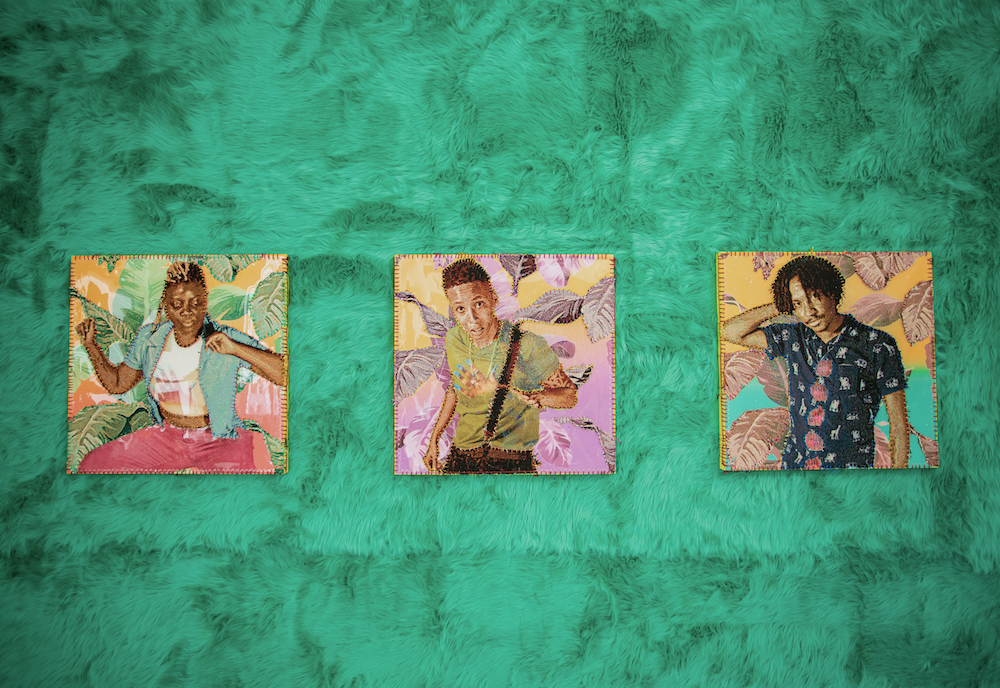
Installation view of April Bey’s “Colonial Swag” at TERN Gallery, photo by © Blair Meadows, courtesy of the artist and TERN Gallery.
WW: Why do you say erroneously?
AB: That’s another part of my process. I like to do things that purists would hate, like sew into wood and resin. I sew fabric into the pieces with unfinished edges. I know that they’re secure because I know how to sew, but I think people who sew professionally, it drives them nuts. It’s a combination of new ways to think about materials and processes, combined with new ways to think about culture and sovereignty. I believe that as long as you learn the rules, you can break them and bend them to accommodate yourself.
I try to make my work aggressively beautiful because that’s the aesthetic of Atlantica, but it’s sinister as well. You get drawn in, and then, due to the title or the imagery, you realize it’s constructed out of completely knockoff fabric that’s been taken from other cultures.
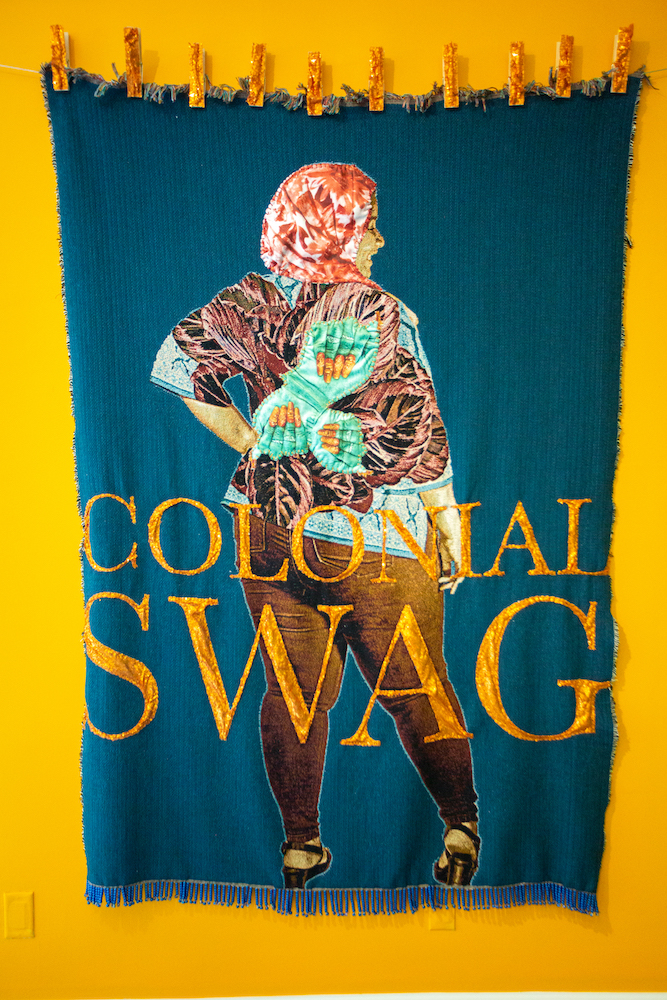
Installation view of April Bey’s “Colonial Swag” at TERN Gallery, photo by © Blair Meadows, courtesy of the artist and TERN Gallery.
WW: Do you feel like you have a dialogue with the subjects, whether during the shoot or while working with their image afterward?
AB: Yeah, definitely. I think that the dialogue there comes from them understanding further what Atlantica is and putting themselves into it, starting to answer their own questions about what they need. Atlantica gives everyone a blank canvas to say, “Okay, if I could create my own planet, my own culture, would I even have any need for gender? And how would that look if we just appeared and none of us had any knowledge of race or gender or class or even currency or poverty?” Those are the kinds of questions and conversations that we have around the work.
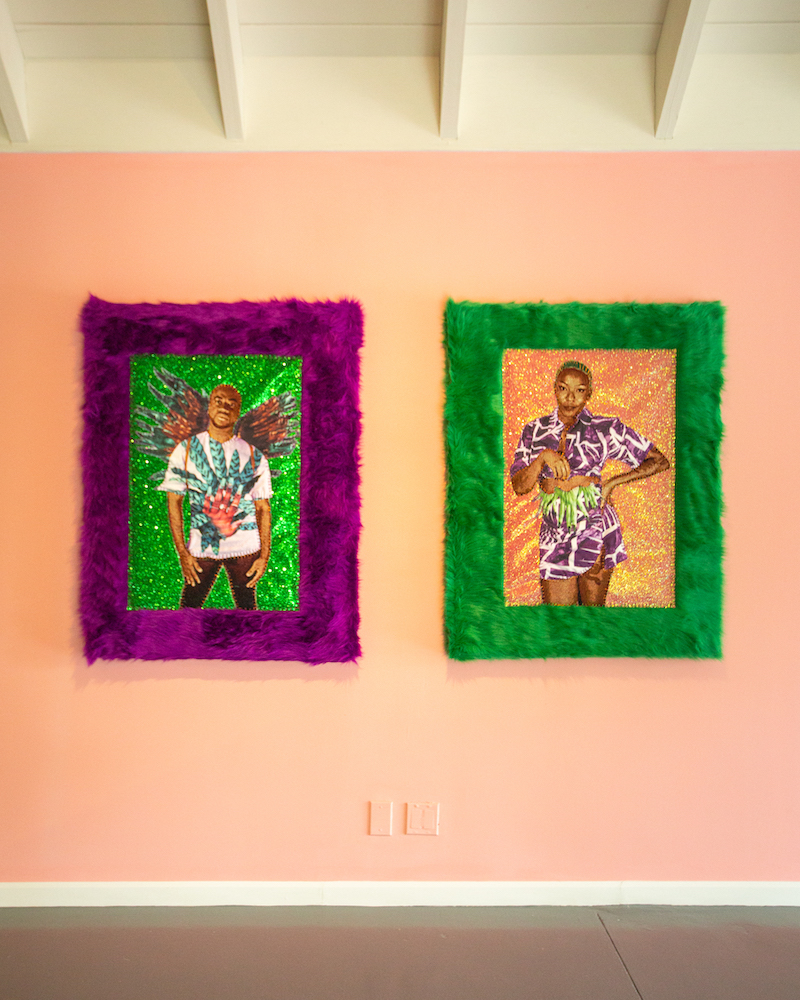
Installation view of April Bey’s “Colonial Swag” at TERN Gallery, photo by © Blair Meadows, courtesy of the artist and TERN Gallery.
WW: How beautiful that this story your dad used to comfort you you’re now sharing with others. What does your dad think of how the story has blossomed?
AB: Oh, he loves it! He was out here for my solo show that opened in L.A., watching everybody, listening to everybody. When we got home that night he asked me to sit on the patio with him, and he was like, “People want to come to our planet, honey.” So that night we talked about religion on Atlantica. What does love look like? What does war look like? What’s our biggest conflict? Right now, the story is that our biggest conflict was people arguing bone-in chicken wings versus boneless chicken wings. Wouldn’t it be great if the only wars that were fought were over a table arguing about chicken wings?
Atlantica isn’t utopian, exactly. It’s not perfect, but it’s different.
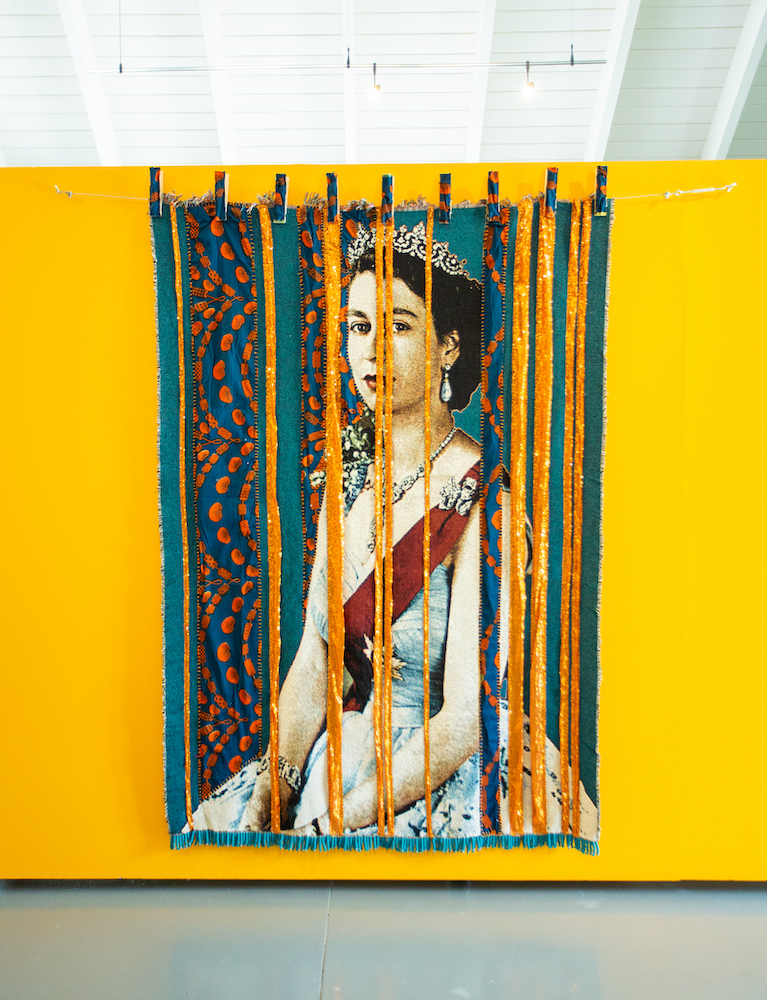
Installation view of April Bey’s “Colonial Swag” at TERN Gallery, photo by © Blair Meadows, courtesy of the artist and TERN Gallery.



